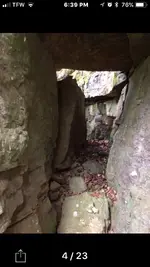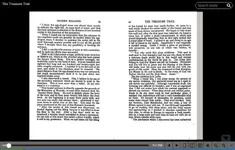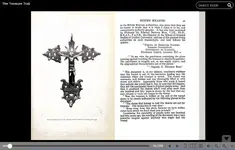Spring,
All your questions have been answered several times in the now 129 pages of this thread.
1. Where are the Jesuit Mines? Very simple. Many of them were reopened and worked. Because of the mineralized nature of the entire area between Tucson and Arispe, prospectors have been crawling all over those mountains from the 1600s until the present. Take for instance, The Wandering Jew Mine:
The Wandering Jew Mine was discovered in about 1870. Remember that phrase "SO NO ONE COULD DETECT THE COVERED WORK." Why would a miner find a very rich ledge of silver/galena, work it for a while, then cover it up and leave it forever? No miner would do that (except maybe Jacob Waltz HAHAHA). No, a silver/galena mine is nothing like a rich gold mine. You can't take out three caches and be set for life. Silver is just not that valuable. You combine the stated Jesuit Documents with the fact that Col Poston did exactly as they instructed, and saw the place he had already found to be worked, and you have proof the Jesuit Documents were right.
2. How rich were they? They were exceedingly rich. They had to be, because the Spanish/Jesuits methods of refining were still very crude. If the ore was not very rich, it is a fact that the Spanish would just forget it.
3. Who operated them? Temporal coadjutors (or laybrothers). Jesuit Priests were bound by Ecclesiastical Precept not to operate any businesses for profit. They were also specifically forbidden to have anything to do (directly or indirectly) with mining.
4. Where di the money go? This one is a LITTLE more problematic. Much of the money that came from what they could legally do, went to the Cabaceras and Colegios of each individual Rectorate (while Mexico was broken up into states like; Sonora, Pimeria Alta, Sinaloa, etc the Jesuits broke up the New World into Rectorates. Each Rectorate had a Cabacera [head] and a Colegio [college]). Wealth from their mining nobody is 100% certain (because it was illegal and the Jesuits were instructed to burn all their correspondences that could damage the reputation of the Order). What some of us have figured out is that there were two paths for that wealth. The one to Rome went via Matamoros to the Bay at Galveston. The path to Manilla (which began later after the Eastern Route began to get more populated), went through Caborca to Loreto (on the Baja Peninsula). From there (initially) down to Punto Cabo San Lucas, where it was secretly loaded onto Manilla Galleons. Later, another Mission (now lost) was built somewhere on the Pacific Coast of Baja for this express purpose. After it was proven that Padre Kino's theory (that California was not an island but a peninsula) was correct, the Western Route went around the Laguna Salada Area, and South into Baja. This may also be where the story of the lost Mission Santa Ysabel came from. It may have been a waystation on the trail to Cabo.
5. If the loot was once hidden in Arizona, why would we assume that it is still hidden there? This question is the MOST vexing of all! But I do have a good answer. The Order of Jesus was restored worldwide in 1814. At this time, Mexico was in the throes of its War for Independence. Mexico was in an almost constant state of war until about 1917. Much of Latin America had caught the Independence Bug. Even once the fighting was over, the places (where I believe) they hid their wealth before being arrested were becoming populated. It would have been nearly impossible for a bunch of Jesuit Priests and a train of mules to head into the mountains unnoticed. If they would have been caught transporting a muletrain full of gold and silver, all their stories of being a poor order, having no wealth, etc would have been exposed as lies. So, they let the wealth stay where it was. The Church does not have a human lifespan. The Church can afford to let that wealth sit in the ground for hundreds of years. OH, and not just in Arizona! California, Baja, New Mexico, Sonora, and maybe others.
NOW WE COME TO THE MAYAN CONNECTION!
There is none really. HAHAHA We get to play "Six Degrees of Kevin Bacon", and I will show you the Jesuits! The gold bars (and silver) found in the area had unmistakable Jesuit connotations (Padre Saeta, Cross with "V", etc). The "Mayan Number Rock" guided the way to that Jesuit Gold. Who would know how the Mayan Numbering System worked in rural Southern Arizona? Maybe a Jesuit Priest formerly stationed in Maya Country? Did the Jesuits interact with the Maya? YES!
Mike









 Heck...Maybe that is another story in itself...rofl
Heck...Maybe that is another story in itself...rofl




